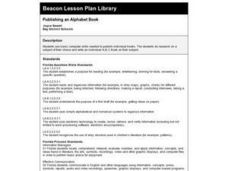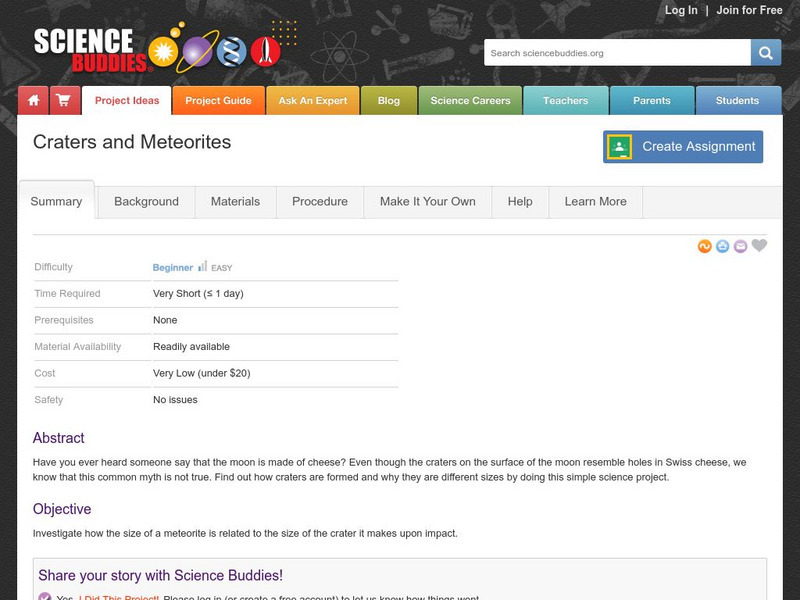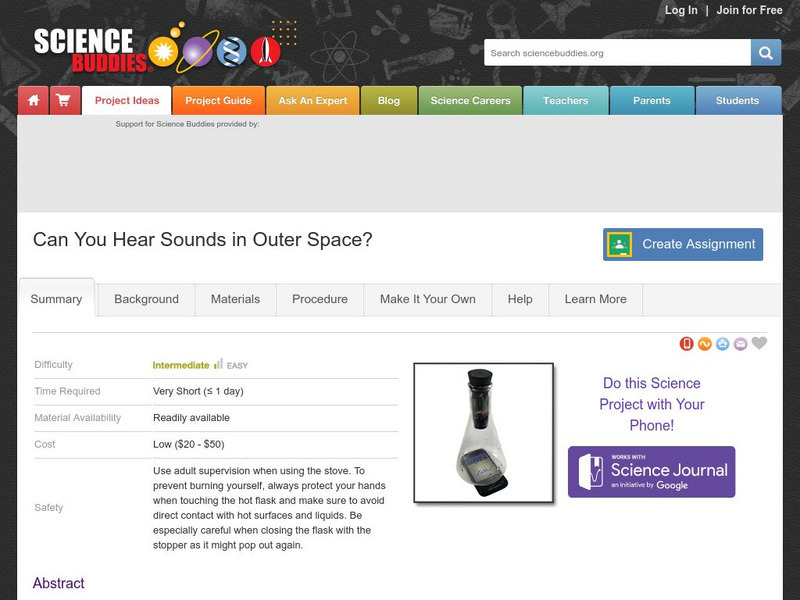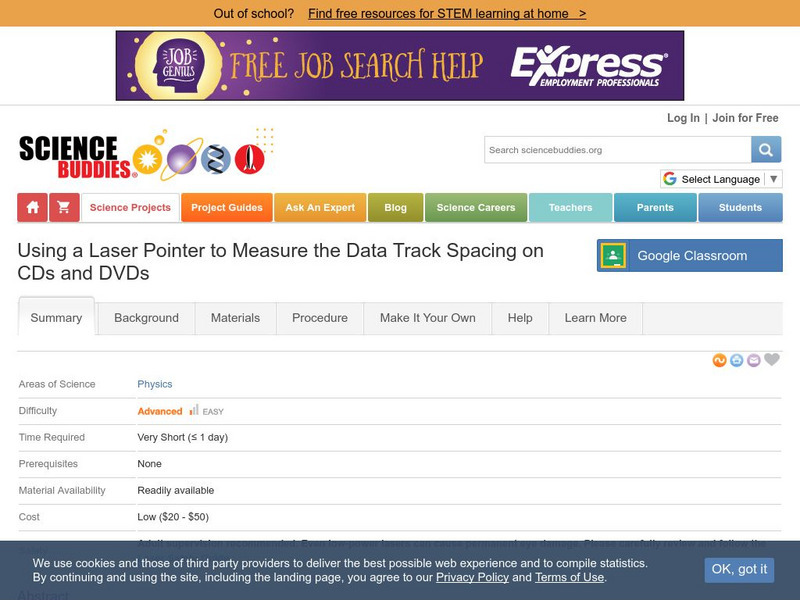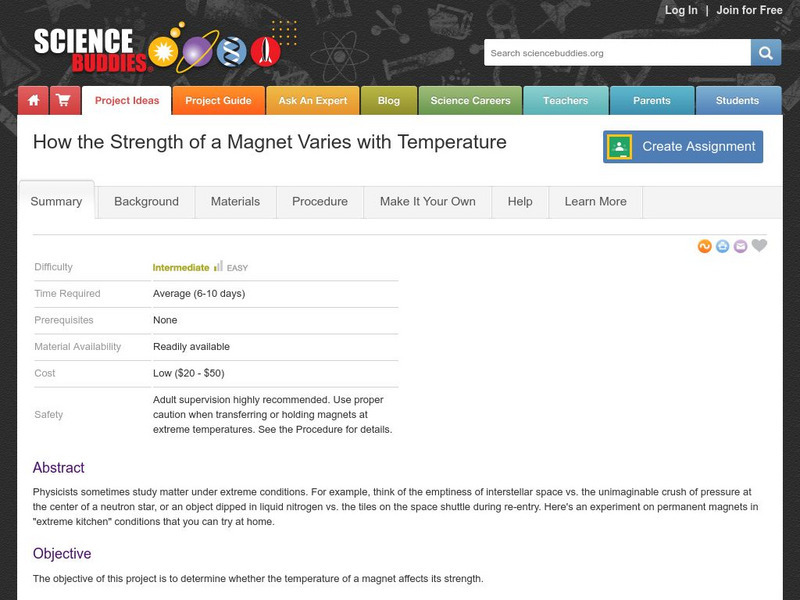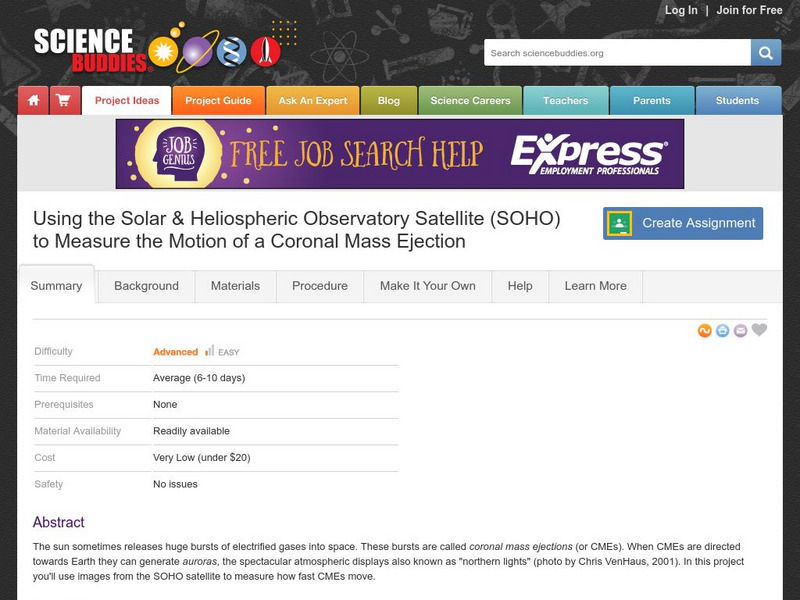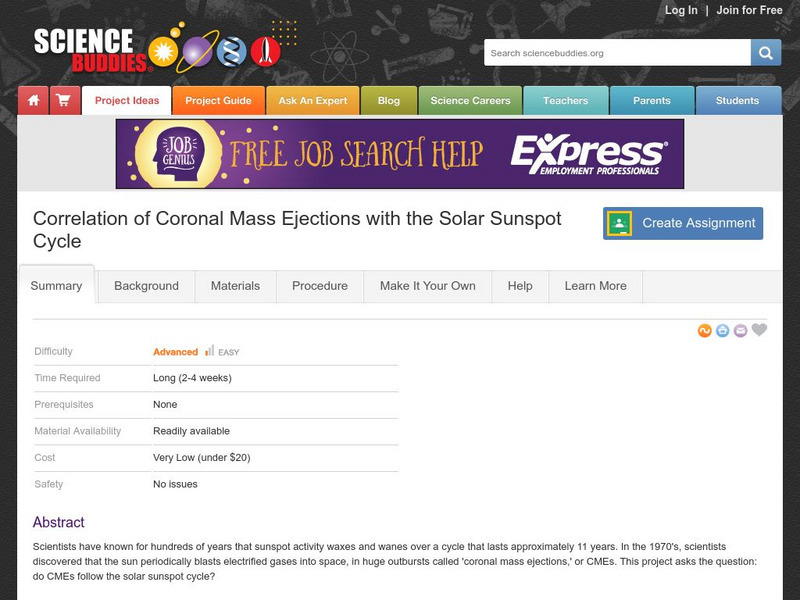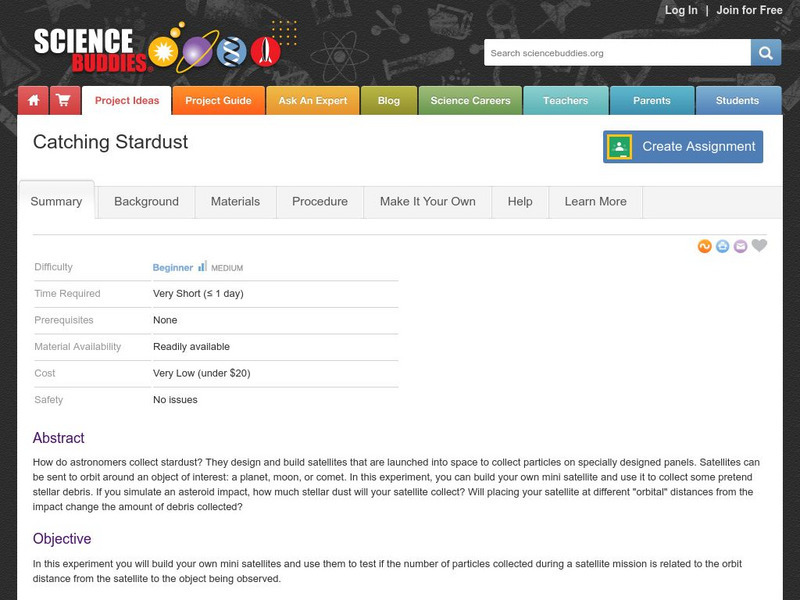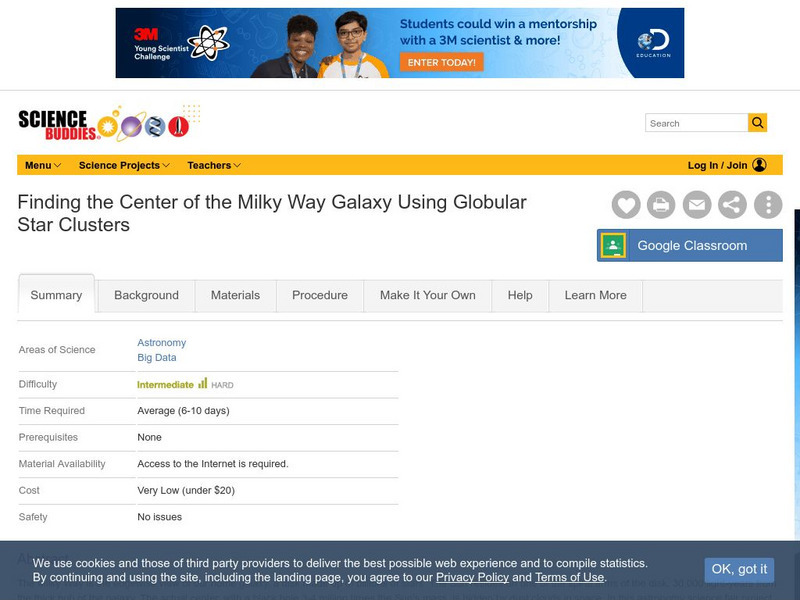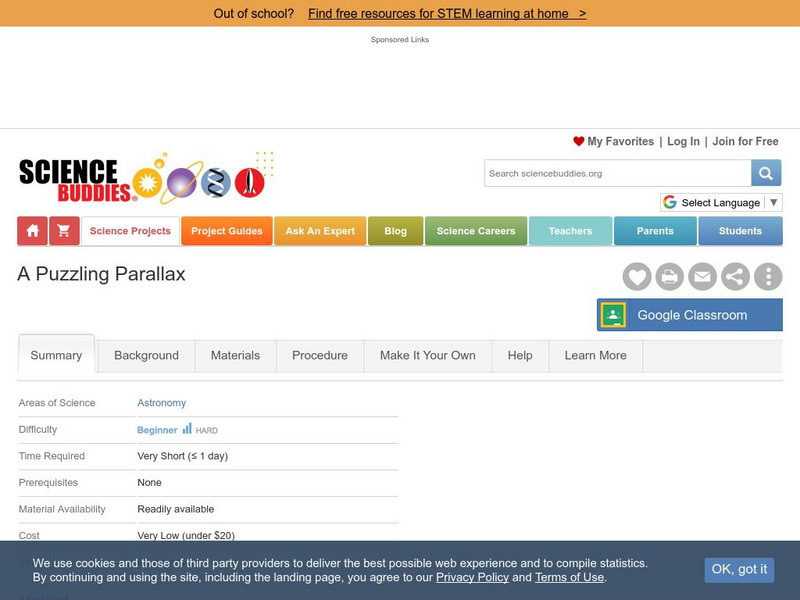Curated OER
Endocrine Excitement!
Learners are divided into a group of hormones and a group of receptors. The hormones have to find their matching receptors, and the pair, once matched, perform a given action. This activity helps students examine the specificity of...
Curated OER
Publishing an Alphabet Book
Students research, write and publish an A,B,C book based on research of their own.
Science Buddies
Science Buddies: Project Ideas: Learn to Design an Ion Engine
The goal of this electricity and electronics science fair project is to understand how ions are used to propel spacecraft in space, and to use a NASA online simulator to design your own ion engine. The Science Buddies project ideas are...
Science Struck
Science Struck: 5 Creative Solar System Project Ideas Kids Can Try
Detailed descriptions of five solar system science projects for students.
Science Buddies
Science Buddies: Craters and Meteorites
Have you ever heard that the moon is made of cheese? Even though the craters on the surface of the moon resemble holes in Swiss cheese, we know that this common myth is not true. Find out how craters are formed and why they are different...
The National Gallery (UK)
National Gallery, London: Ite: Learning Ideas and Outcomes: Subject Focus
This extensive lesson plan uses the painting 'A View of Het Steen in the Early Morning' as a starting point to learning in science. Students will use the work by Reubens to learn about a variety of animals and their habitats.
Science Buddies
Science Buddies: Outer Space, the Silent Frontier: An Experiment on Sound Waves
In outer space there is utter silence. There are no sounds of traffic jams or thunderstorms or crashing waves. No buzzing bees or babies crying. Just silence. In this experiment, you will discover why empty space is void of sound.
Science Buddies
Science Buddies: Image Compression vs. Image Quality: Finding the Best Tradeoff
In this project you'll learn about how digital image files are encoded, and how digital images can be compressed so that the files take up less storage space and can be transmitted more quickly. You will also measure the quality of...
Science Buddies
Science Buddies: Using Laser Pointer to Measure Data Track Spacing on C Ds, Dv Ds
You've probably noticed the colorful patterns "reflecting" from the shiny surface of a CD disk. What you are seeing is actually diffraction of white light, and the rainbows of color are diffraction patterns. In this project you'll learn...
Science Buddies
Science Buddies: Digital Pinhole Camera
If you sit under a leafy tree on a sunny day, you may notice spots of sunlight on the ground from light passing through spaces between the leaves. Try putting a piece of cardboard on the ground and examining the spots of light on the...
Science Buddies
Science Buddies: How the Strength of a Magnet Varies With Temperature
Physicists sometimes study matter under extreme conditions. For example, think of the emptiness of interstellar space vs. the unimaginable crush of pressure at the center of a neutron star, or an object dipped in liquid nitrogen vs. the...
Science Buddies
Science Buddies: Sand Structure: Measuring Density and Porosity of Sand
For many kids, a day at the beach would not be complete without building a sandcastle. Have you ever wondered how it is that you can pack sand into a mold for a sandcastle? Do some kinds of sand pack better than others? This project will...
Science Buddies
Science Buddies: Rock On! Recording Digital Data With Magnets
This is a straightforward project that shows you how data can be digitized and stored on magnetic recording media. You'll learn how alpha-numeric characters are digitized, and you'll use bar magnets to represent the individual data...
Science Buddies
Science Buddies: Observatory Satellite Measures Motion of Coronal Mass Ejection
The sun sometimes releases huge bursts of electrified gases into space. These bursts are called coronal mass ejections (or CMEs). When CMEs are directed towards Earth they can generate auroras, the spectacular atmospheric displays also...
Science Buddies
Science Buddies: Correlation of Coronal Mass Ejections With Solar Sunspot Cycle
Scientists have known for hundreds of years that sunspot activity waxes and wanes over a cycle that lasts approximately 11 years. In the 1970's, scientists discovered that the sun periodically blasts electrified gases into space, in huge...
Science Buddies
Science Buddies: Only if They Think They Can Get Away With It?
How many times have you noticed someone who looks perfectly healthy using a parking space reserved for the handicapped at a busy shopping center? If this behavior gets you steamed, you might be interested in studying how to discourage...
Science Buddies
Science Buddies: How Does Color Affect Heating by Absorption of Light?
Light is an example of an electromagnetic wave. Electromagnetic waves can travel through the vacuum of interstellar space. They do not depend on an external medium-unlike a mechanical wave such as a sound wave which must travel through...
Science Buddies
Science Buddies: Tail Wagging and Brain Lateralization
The left brain is supposed to be better at language, and organizing sequential actions, the right brain is supposed to be better at visualizing orientations in space, making and listening to music, and deciphering the emotions of others....
Science Buddies
Science Buddies: M&m Geometry
Geometry is the study of how to use math to describe and investigate different points, lines and shapes. The way that a shape is described in geometry is with a formula, which is simply a mathematical way to calculate different...
Science Buddies
Science Buddies: Catching Stardust
How do astronomers collect stardust? They design and build satellites that are launched into space to collect particles on specially designed panels. Satellites can be sent to orbit around an object of interest: a planet, moon, or comet....
Science Buddies
Science Buddies: Porosity
Soils are made of particles of different types and sizes. The space between particles is called pore space. Pore space determines the amount of water that a given volume of soil can hold. Porosity is the percentage of the total volume of...
Science Buddies
Science Buddies: Find Center of Milky Way Galaxy Using Globular Star Clusters
The Milky Way is the edgewise view of our home galaxy, a disk made up of billions of stars. The Sun resides on one of the spiral arms of the disk, 30,000 light-years from the thick hub of the galaxy. The actual center, with a black hole...
Science Buddies
Science Buddies: A Puzzling Parallax
Did you know that ancient astronomers could measure the distance to other stars? They could also distinguish between stars and planets. How could they do that without modern technology of telescopes? See if you can discover the link...
NASA
Nasa Space Place: Do a Science Fair Project!
Your science fair project may do one of three things: test an idea (hypothesis), answer a question, and/or show how nature works. Learn the steps involved in a project and get some great topic ideas.



